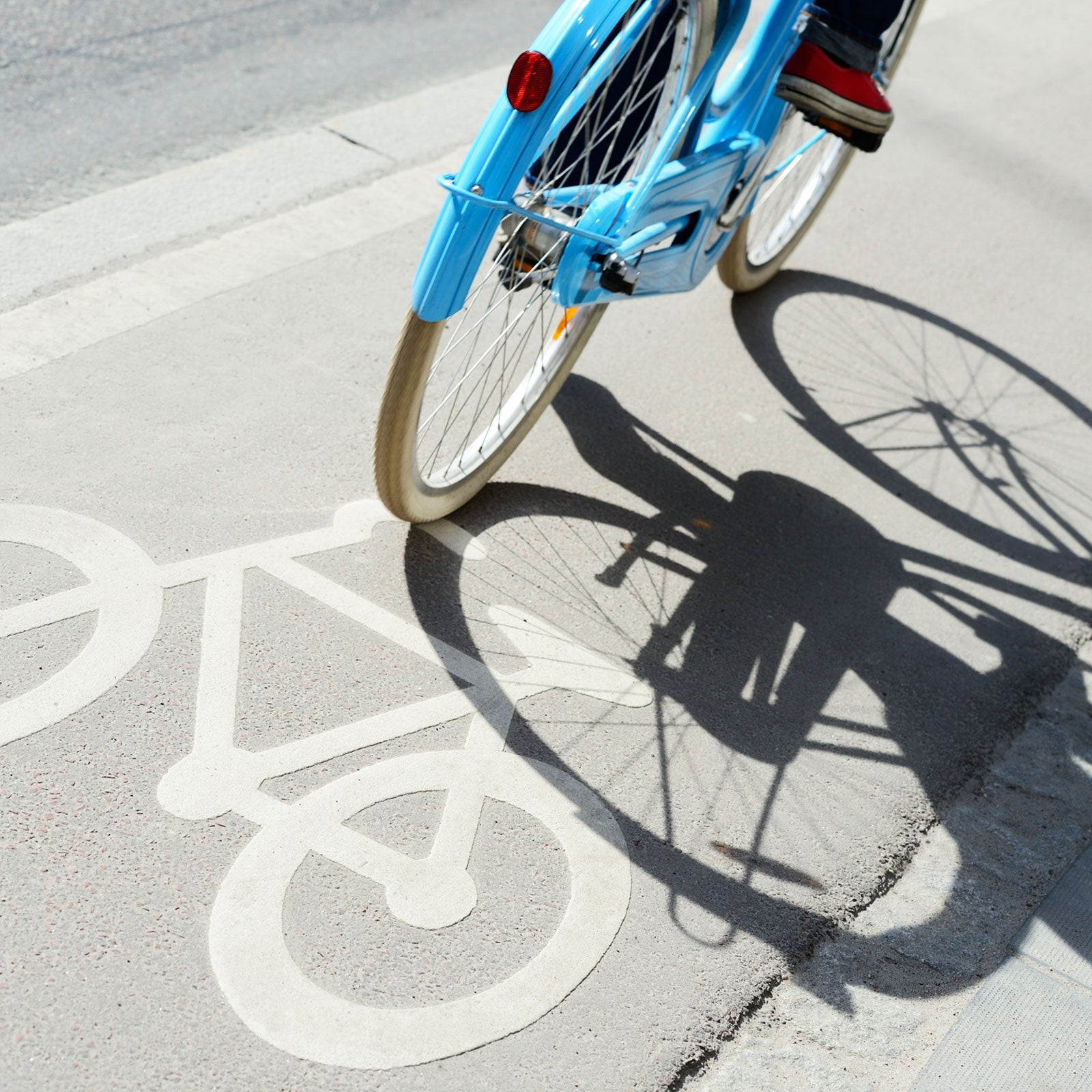One of the long-standing arguments against building bike lanes is that cyclists are freeloaders: we enjoy the benefits of road networks without paying gas and vehicle taxes, so if we want our own special lanes, we should be taxed to build them.
This is, of course, . The taxes that fund road construction come from a wide variety of sources, including income, sales, and property taxes. If anything, people who ride instead of drive are disproportionately supporting deadbeat car owners. (This is to say nothing of widely available .)
Now we may be able to add another counterargument. In the past five months, two new studies have shown that protected bike lanes make cities safer for all residents—not just cyclists��and not just with regard to traffic accidents. They’re part of a growing pile of evidence suggesting��that bike lanes are more than just a way for people to get around on two wheels. They have profound, sophisticated effects on a city’s safety and social fabric. Done right, bike lanes may be one key to a happier, healthier city for everyone who lives there.
The most recent of those studies, published in May in the , focuses on a paradox: cycling is a more dangerous mode of travel than driving or transit in many countries. But cities with higher rates of cycling are not only , they also��seem to have of fatal and severe-injury crashes for all residents. (There’s evidence of for cities with high transit—bus and rail—use.)
Wesley Marshall and Nicholas Ferenchak, professors of civil engineering at the University of Colorado at Denver and the University of New Mexico, respectively, dove into a massive amount of data��covering 12 large American cities, ranging from Minneapolis (the smallest, with a population of 413,651) to Chicago (2,704,958), to find out why. The data trove included 13 years of fatality and severe-injury records, demographic and commuting data from the Census and the American Community Survey, and extensive GIS mapping of available cycling lanes��classified by type, like��protected bike lanes versus “sharrows”—those lane markings with an image of a��cyclist below��two arrows, indicating��that cyclists can use a regular traffic lane.
Marshall and Ferenchak hypothesized three likely causes for improvements in traffic safety. First: more people cycling somehow changes driver behavior (the��“safety in numbers” theory). Second: more and��better bike lanes make riding safer. Third: socioeconomic factors like wealth and gentrification are associated with improved street and bike-lane��design.
Since the cities had different levels of cycling infrastructure and rates of cycling, Marshall and Ferenchak could isolate safety changes that might have resulted from any of the three variables. “We were focused on road fatalities overall—drivers and vehicle occupants and pedestrians and cyclists,” Marshall told me��in an interview, “and safety in numbers just turned out to be nonsignificant in our models. What did explain stuff was infrastructure.”
Specifically, Marshall added, the kind of bike lanes mattered. “[The presence of] protected bike lanes was the only significant correlation” with improved safety, he said. “If you replaced that with painted bike lanes or sharrows, [safety gains] turned out to be nonsignificant.” What’s more, the safety gains from protected bike lanes lowered crash and injury rates for all residents, including drivers and pedestrians. Sharrows seemed to actually be less safe.��
Marshall and Ferenchak’s findings have deep implications for street planning. It’s the first time we’ve seen statistical modeling suggesting��that the safety benefit from bike lanes—one kind of bike lane in particular—is due to��the lanes themselves, not the increased visibility that comes with more riders,��and it suggests that the safety improvements benefit drivers and pedestrians, too.��
When we spoke, Marshall suggested this might be in part because protected bike lanes include street-design changes that generally are associated with lower traffic speeds, so even when crashes do happen, they are less likely to kill and injure victims. He and Ferenchak didn’t have speed data at a block-by-block level for analysis, but they may try to study it��in the future.
The researchers also noticed, as others have, that there were safety differences based on demographic variables like income. “Here in Denver, if you start down a street in a rich neighborhood and go toward a poor one, the characteristics of the street change,” said Marshall. “Big beautiful trees go away, the bike lanes go away. So there are physical things happening here that these variables [like wealth] are a proxy for.”
Anne Lusk, a research scientist at Harvard who has studied urban cycling for almost four decades, is looking into the relationship between income, race, and bike infrastructure. In��the February 2019 issue of the��International Journal of Environmental Research and Public Health, she of a survey of minority and low-income residents in Boston that had several telling conclusions.
Lusk gathered small groups of participants, showed them photos of various types of cycling infrastructure, and asked them to rank each from one to six for both crash safety and crime safety. Each group came from one of two general backgrounds, which Lusk termed community sense (church or YMCA members) and street sense (halfway houses, homeless shelters, and gang members).����
Participants in both groups ranked protected bike lanes as the second safest for crash risk��but the safest for crime risk. Off-street greenway paths, by contrast, were ranked safest for crashes but the least safe for crime. Participants explained their thinking: multi-use greenway paths are often set in relatively secluded��forested parks and open spaces, rather than next to roads, which means they’re places where criminals could hide with few bystanders to intervene.��
Survey respondents liked protected bike lanes because they offer��a reliably safe way to travel that isn’t isolated from the city. They wanted greenery like trees on the street but without obstructed views that might conceal hiding places. They wanted street-level lighting for visibility, and they wanted the lanes to be near shops and restaurants, where there are other people around. In other words: they generally want protected bike lanes, too, just with some specific design elements that not only make for safer riding��but safer daily life.
“You have to come up with a new way to think of crime prevention through environmental design,” Lusk told me, “and allow strangers��to be going through the space who are not in cars.”��
Those kinds of bike lanes do exist in many cities but generally not in and around low-income neighborhoods, said Lusk. That, she thinks, is because cities largely aren’t asking their low-income residents what they want. “The current system has bicycle facilities built based on advocacy,” she said bluntly. “Advocacy demands that citizens spend considerable unpaid time at hearings��and that the advocates are highly educated to know what to ask for��and have the social capital to know to whom to make the request. Why would a low-income person,��who maybe has three jobs, want to go to a hearing on a Thursday night?”��
There are other obstacles. Bike infrastructure has something of a mixed reception among low-income and minority communities, where bike lanes and bike-share initiatives��have been met with the suspicion that they’re a that will push out longtime residents. Their concern is partly based on a fear of broader neighborhood changes sometimes associated with bike lanes. And��, low-income��residents are often that will cost them on-street parking.��
That complicates both Lusk’s findings and showing that low-income households (less than $25,000) use bicycles for transportation at two to three��times the rate of higher-income households ($75,000 and up). Together��the��data suggests that minority residents do want bike lanes and would benefit from them, but it’s going to take to change perceptions.��
Protected bike lanes are widely used in Europe (in particular the Netherlands and Denmark). But other than a small handful of early pilot projects from the late 1960s, protected bike lanes in the U.S. were all but unheard of until 2008, when New York City installed the first modern protected lane with a six-block pilot project on Ninth��Avenue. Since then��the number of protected lanes in the U.S. has , although they still make up a small portion of overall bike infrastructure.
Will Lusk, Marshall, and Ferenchak’s research have an impact on encouraging that growth to continue? Maybe. This year��the American Association of State Highway and Transportation Officials is updating its bikeway-design guide. The AASHTO guide is essentially the bible for street design. It specifies best civil-engineering practices for��objectives��like how wide bike lanes should be, how intersections are designed, and which facilities fit best in different traffic settings. AASHTO��provides a kind of engineering and legal cover for local officials: whatever happens in terms of safety, they��can always say that they built a street according to recommended design standards.
The original guide, published��in 1974, included protected bike lanes. But from vocal advocates, they all but disappeared from subsequent revisions. Even the fourth edition, in 2012, conspicuously avoids mentioning them. The 2019 revision is, realistically, the first time that the new guide will include specific engineering-design guidance for protected bike lanes.��
That’s important��because there’s a wide range of ways cities are implementing protected bike lanes. Some use curbs or sturdy concrete planters to separate��bikes from cars. Others use parked cars as the barrier. Still others use flexible white plastic posts��that Lusk derisively calls “cigarettes standing on end” because they provide zero real physical protection. AASHTO standardization recommending sturdy separations for protected bike lanes could lead to even more safety gains.
It could also give researchers an easier time replicating Marshall and Ferenchak’s data in the future. Marshall said he’s unaware of another study that examines whether different types of bike lanes have different impacts on safety, adding that even their data only goes through 2013, the latest year for which full injury data was available. Even if a researcher had wanted to, they likely couldn’t have shown the difference between protected lanes and other types. “Protected lanes didn’t exist,” he said. “How would we know?”
The 2019 AASHTO update is already in progress and likely won’t reflect Marshall and Lusk’s latest findings. But��it might finally provide some concrete engineering standards for how to build protected lanes. If transportation planners and engineers are looking for an argument for building protected lanes, there’s a clear message in the results of these studies: bike lanes aren’t just for cyclists. The type of lanes we build, and how and where they’re folded into the urban environment, have profound impacts for a city’s physical and social health. Maybe, that thinking goes, bike lanes aren’t just bike lanes.


